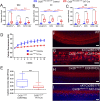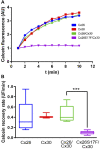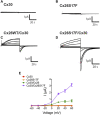Expression of KID syndromic mutation Cx26S17F produces hyperactive hemichannels in supporting cells of the organ of Corti
- PMID: 36699003
- PMCID: PMC9868548
- DOI: 10.3389/fcell.2022.1071202
Expression of KID syndromic mutation Cx26S17F produces hyperactive hemichannels in supporting cells of the organ of Corti
Abstract
Some mutations in gap junction protein Connexin 26 (Cx26) lead to syndromic deafness, where hearing impairment is associated with skin disease, like in Keratitis Ichthyosis Deafness (KID) syndrome. This condition has been linked to hyperactivity of connexin hemichannels but this has never been demonstrated in cochlear tissue. Moreover, some KID mutants, like Cx26S17F, form hyperactive HCs only when co-expressed with other wild-type connexins. In this work, we evaluated the functional consequences of expressing a KID syndromic mutation, Cx26S17F, in the transgenic mouse cochlea and whether co-expression of Cx26S17F and Cx30 leads to the formation of hyperactive HCs. Indeed, we found that cochlear explants from a constitutive knock-in Cx26S17F mouse or conditional in vitro cochlear expression of Cx26S17F produces hyperactive HCs in supporting cells of the organ of Corti. These conditions also produce loss of hair cells stereocilia. In supporting cells, we found high co-localization between Cx26S17F and Cx30. The functional properties of HCs formed in cells co-expressing Cx26S17F and Cx30 were also studied in oocytes and HeLa cells. Under the recording conditions used in this study Cx26S17F did not form functional HCs and GJCs, but cells co-expressing Cx26S17F and Cx30 present hyperactive HCs insensitive to HCs blockers, Ca2+ and La3+, resulting in more Ca2+ influx and cellular damage. Molecular dynamic analysis of putative heteromeric HC formed by Cx26S17F and Cx30 presents alterations in extracellular Ca2+ binding sites. These results support that in KID syndrome, hyperactive HCs are formed by the interaction between Cx26S17F and Cx30 in supporting cells probably causing damage to hair cells associated to deafness.
Keywords: cochlea; connexin; gap junction; hemichannel; organ of Corti; syndromic deafness.
Copyright © 2023 Abbott, García, Villanelo, Flores-Muñoz, Ceriani, Maripillán, Novoa-Molina, Figueroa-Cares, Pérez-Acle, Sáez, Sánchez and Martínez.
Conflict of interest statement
The authors declare that the research was conducted in the absence of any commercial or financial relationships that could be construed as a potential conflict of interest.
Figures








Similar articles
-
Keratitis-ichthyosis-deafness syndrome-associated Cx26 mutants produce nonfunctional gap junctions but hyperactive hemichannels when co-expressed with wild type Cx43.J Invest Dermatol. 2015 May;135(5):1338-1347. doi: 10.1038/jid.2015.20. Epub 2015 Jan 27. J Invest Dermatol. 2015. PMID: 25625422 Free PMC article.
-
The connexin26 S17F mouse mutant represents a model for the human hereditary keratitis-ichthyosis-deafness syndrome.Hum Mol Genet. 2011 Jan 1;20(1):28-39. doi: 10.1093/hmg/ddq429. Epub 2010 Oct 6. Hum Mol Genet. 2011. PMID: 20926451
-
Aberrant Cx26 hemichannels and keratitis-ichthyosis-deafness syndrome: insights into syndromic hearing loss.Front Cell Neurosci. 2014 Oct 27;8:354. doi: 10.3389/fncel.2014.00354. eCollection 2014. Front Cell Neurosci. 2014. PMID: 25386120 Free PMC article. Review.
-
Altered epidermal lipid processing and calcium distribution in the KID syndrome mouse model Cx26S17F.FEBS Lett. 2015 Jul 8;589(15):1904-10. doi: 10.1016/j.febslet.2015.05.047. Epub 2015 Jun 9. FEBS Lett. 2015. PMID: 26070424 Free PMC article.
-
From Hyperactive Connexin26 Hemichannels to Impairments in Epidermal Calcium Gradient and Permeability Barrier in the Keratitis-Ichthyosis-Deafness Syndrome.J Invest Dermatol. 2016 Mar;136(3):574-583. doi: 10.1016/j.jid.2015.11.017. Epub 2016 Jan 8. J Invest Dermatol. 2016. PMID: 26777423 Review.
Cited by
-
Functional Consequences of Pathogenic Variants of the GJB2 Gene (Cx26) Localized in Different Cx26 Domains.Biomolecules. 2023 Oct 13;13(10):1521. doi: 10.3390/biom13101521. Biomolecules. 2023. PMID: 37892203 Free PMC article. Review.
-
Calcium Regulation of Connexin Hemichannels.Int J Mol Sci. 2024 Jun 15;25(12):6594. doi: 10.3390/ijms25126594. Int J Mol Sci. 2024. PMID: 38928300 Free PMC article. Review.
-
Simulation-predicted and -explained inheritance model of pathogenicity confirmed by transgenic mice models.Comput Struct Biotechnol J. 2023 Nov 18;21:5698-5711. doi: 10.1016/j.csbj.2023.11.026. eCollection 2023. Comput Struct Biotechnol J. 2023. PMID: 38074473 Free PMC article.
-
A pore locus in the E1 domain differentially regulates Cx26 and Cx30 hemichannel function.J Gen Physiol. 2024 Nov 4;156(11):e202313502. doi: 10.1085/jgp.202313502. Epub 2024 Sep 20. J Gen Physiol. 2024. PMID: 39302316 Free PMC article.
References
-
- Abraham M. J., Murtola T., Schulz R., Páll S., Smith J. C., Hess B., et al. (2015). Gromacs: High performance molecular simulations through multi-level parallelism from laptops to supercomputers. SoftwareX 1, 19–25. 10.1016/j.softx.2015.06.001 - DOI
LinkOut - more resources
Full Text Sources
Molecular Biology Databases
Research Materials
Miscellaneous

